
 This post is sort of dedicated to P.Singh. Let me first begin by saying that I agreed with ALL (and I use that word only after re-reading all of his comments) of the points that he made in a prior post (not all of his comments in other posts, but I digress….).
This post is sort of dedicated to P.Singh. Let me first begin by saying that I agreed with ALL (and I use that word only after re-reading all of his comments) of the points that he made in a prior post (not all of his comments in other posts, but I digress….).
However, I did want to revisit the topic of Dr. Pashaura Singh in light of some more news, posit a contrarian viewpoint based on an academic article, and then revisit the question of endowed Sikh chairs.
Update on Dr. Pashaura Singh
On Friday of last week, Sikhs throughout California organized buses down to the UC Riverside campus to protest Dr. Pashaura Singh’s hire as the chair of the endowed Jasbir Singh Saini Chair in Sikh and Punjabi Language Studies. While newspaper articles stated that over 300 people were in attendance, my own eye-witness sources claim that it was in excess of 500.
It’s Friday. Hooray! On that note, I think a light hearted post is needed for today. As David Letterman recently pointed out: McCain taking Palin to meet with world leaders at the United Nations this week was like “take-your-daughter-to-work day.” Oooh Snap!
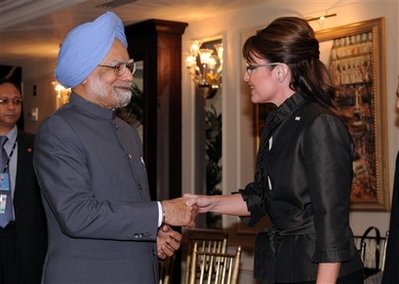
Hopefully Manmohan Singh didn’t gush over Governer’s Palin’s looks as his neighbor did earlier this week!
Enjoy the Presidential Debate tonight and have a good weekend Langarites!
Heads-up friends, the season of the “Spinning Wheel Festival” is about to begin across North America this autumn. Celebrating Sikh films and art, the first stop will be in New York City on Saturday, October 04, 2008 at the Asia Society & Museum (p.s. that’s next Saturday). Buy your tickets NOW! The wonderful Rabbi Shergill will be performing at the opening gala (yes I am really biased here … I heart Rabbi Shergill) and DJ Rekha will be literally “spinning” at the after party.
Films a the NYC festival will range from documentaries on Pahelwani (i.e. Panjabi wrestling) and Kaba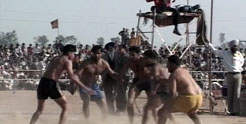 ddi-playing Canadian police officers to issues affecting the Sikh community from 1984 and post-9/11 hate crimes. There will also be short and feature films. For example, one on a young boy’
ddi-playing Canadian police officers to issues affecting the Sikh community from 1984 and post-9/11 hate crimes. There will also be short and feature films. For example, one on a young boy’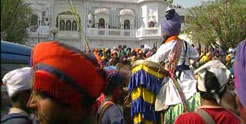 s struggle to keep his hair while his family fears the obstacles he will encounter and another on “… a young Sikh doctor struggling with the inequities of the American Health System and ultimately his own identity”. The Holy Duels of Hola Mohalla is a film looking at the Khalsa Panth.
s struggle to keep his hair while his family fears the obstacles he will encounter and another on “… a young Sikh doctor struggling with the inequities of the American Health System and ultimately his own identity”. The Holy Duels of Hola Mohalla is a film looking at the Khalsa Panth.
The films seem interesting both in content and presentation. The stories are grounded in the realities many of us encounter everyday. You can get a full listing of the films and their synopses here.
In the past, I have attended the “Spinning Wheel Festival” at one of its many North American stops and found it a great space for artists and art-enthusiasts to be exposed to Sikh creativity. I remember there being a panel discussion with the directors and the audience. We don’t have too many of these creative opportunities in our community even though we spend plenty of time and space advertising foreign medical schools in Poland, China, and the Caribbean.
I have found that some films are really hit or miss at these festivals, but it’s expected sense the focus is on cultivating and inspiring creativity; while, building a permanent Sikh film festival for years to come. Cash prizes are awarded to the “bests” in various categories. I have been told that the listing and quality of films varies across the different North American stops.
At the end of the day why not go, especially if it’s close by. I personally think it’s worth a visit as an act of supporting Sikh arts and learning about the various issues affecting our community. Sometimes we get too caught up in our own worlds and don’t realize these issues are taking place or we are in amidst of them and they become normal parts of our lives leaving very little room for reflection or exposure to others’ perceptions. Thus, it’s an 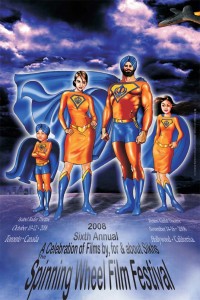 opportunity to get a fresh/new look at various issues.
opportunity to get a fresh/new look at various issues.
Lastly, the arts, from painting and photography to films and music, are our community’s soul! They help us speak in ways we can’t always articulate. So go save your soul and attend a Sikh artistic event! 
Okay, enough of the attempt at convincing … the other North American stops will be:
- Toronto, Canada from October 10-12, 2008 at the Isabel Bader Theatre.
- Hollywood, California from November 14-16, 2008 at the Writers Guild Theatre.
Are ya’ll thinking of going? What have your experiences been at the various Spinning Wheel Festivals? Does anyone know of other North American stops?
p.p.s. The Toronto and Hollywood poster is really interesting isn’t it … a conversation in of itself!
We are only beginning to hear about the prevalence of postpartum depression in the larger community, so it comes as no surprise to me that we hear about it even less within the South Asian community. Recent research suggests that Indian women, particularly new immigrants, may be at a higher risk of postpartum depression than their non-Indian counterparts. Experts suggest isolation stemming from the immigrant experience and a lack of the traditional support system often found in the home countries, as reasons for increased prevalence among Indian women.
In the United States, about one in 10 women suffers from postpartum depression (PPD). South Asian women may be at a higher risk for PPD, due to the impact of acculturation and cultural customs including factors such as arranged marriage and the gender of the child.
A groundbreaking 2007 study published in the Journal of Obstetrics and Gynecology concluded that 28 percent of Indian American women suffered mild symptoms of postpartum depression and 24 percent suffered major symptoms. The paper-titled “Immigrant Asian Indian Women and Postpartum Depression” is the only study of Indian American women and postpartum depression. [link]
Dr. Nirmaljit Dhami, medical director of the new Maternal Outreach Mood Services program at El Camino Hospital in Mountain View, Calif., says that post-birth, many women present symptoms of tearfulness and crying. Sadness, emptiness, feeling overwhelmed, having a short temper, appetite changes and withdrawal from family and friends are all symptoms common to postpartum depression. [link]
This day marks the 221th anniversary of the signing of the U.S. Constitution.
No matter how much we argue about the details of its meaning today, in the opinion of many, the Constitution signed in Philadelphia on September 17, 1787 represents the greatest expression of statesmanship and compromise ever written. In just four hand-written pages, the Constitution gives us no less than the owners’ manual to the greatest form of government the world has ever known. [Link]
To commemorate this historic day, the U.S. Congress designated September 17 as “Constitution Day” and required all schools that receive federal financial assistance to “provide some educational programming about the U.S. Constitution on or around Sept. 17[.]” Despite the brilliance of the American constitutional system and the congressional mandate for schools to study the Constitution on at least one day, ignorance of the American government remains high. For example:
- When asked to name two of Snow White’s Seven Dwarfs and two of the nine U.S. Supreme Court Justices, 77% of Americans polled were able to identify two dwarfs, while only 24% could name two Supreme Court Justices.
- 73% of those polled [were] able to name all three of The Three Stooges, while only 42% could name the three branches of government. [Link]
Further, more American teenagers
- know the Fresh Prince of Bel-Air than know the Chief Justice of the Supreme Court (94.7% to 2.2%)
- know which city has the zip code “90210” than the city in which the U.S. Constitution was written (75% to 25%) [Link]
These and similar statistics should alarm Americans and they reflect the need for greater civics education in American schools. But we should not think that this is a concern from which Sikhs are exempt.
We have had a lot of discussion about the Sikh identity here on TLH, so it is no surprise that when I saw this movie poster I immediately wanted to bring it to your attention.
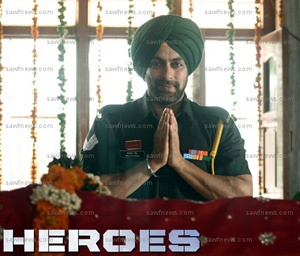 Bollywood is doing it again – another movie with Sikhs. But instead of what we have seen in the past with Sikhs often portrayed as unflattering villains and goofballs, it seems that the trend now is to cast people in Sikhs roles where the Sikhs are the heroes. I suppose it is partly in that spirit that the movie is called “Heroes.”
Bollywood is doing it again – another movie with Sikhs. But instead of what we have seen in the past with Sikhs often portrayed as unflattering villains and goofballs, it seems that the trend now is to cast people in Sikhs roles where the Sikhs are the heroes. I suppose it is partly in that spirit that the movie is called “Heroes.”
Heroes is about two friends who journey through India meeting everyday heroes, at least one of whom is a Sikh. But that is not the part that interested me of course. The interesting part is not the story line, but all of the press that Salman Khan (the actor who plays a Sikh hero) has gotten for his attempt to play a real Sikh.
Salman Khan [is] seen in a Sikh makeover for the first time ever and he makes a good looking jatt Sikh with a beautifully tied turban. He grew his beard for three weeks before the filming for an authentic bearded Sikh look. Source.
I think this is probably the first time that I have heard this happening. Although, I think actor Sunny Deol may have grown his own beard for a couple of his roles as a Sikh – it has never been so explicitly commended or publicized. I’m not sure how I come down on this, but all the press does point to a deliberate effort by Bollywood to NOT-offend Sikhs, which I think is a positive move on the film industries part.
Update: wow, I did an AWFUL job of summarizing SRI’s first webinar. (Apologies to the good folks at SRI) Here’s a better summary:
Sikh Theology – A Gurmat Framework: The first session comprised of introducing an approach to Sikhi and recognizing how Guru Nanak Sahib revolutionarily delivered a message of Oneness through illustrating a direct connection between ideas and practice. We engaged in understanding what ‘Guru’ means in the Sikh context and how we can begin to comprehend the Guru’s wisdom, Gurmat. To develop this understanding, three facets of bani (scripture), tavarikh (history) and rahit (lifestyle) were introduced. The greatness of a religion is when harmonious balance between Ultimate reality and visible form is exemplified thru the aforesaid facets. We concluded with Puran Singh’s rendering on the Guru’s vision, “It sweetens you and your sweetness sweetens all life around. At your sight, the lamb and the tiger must drink at the same pool.”
And some info on session 2:
Bani – The Message: In session two, we continued to build on our understanding of the Guru’s message; We engaged in actively learning about the scriptural canon, the Guru Granth Sahib. In covering topics as the compilation, contributors, structure, language and content of Guru Granth Sahib, we tackled questions such as, “How do we know Guru Granth Sahib is the Guru?” and “What is the Sabad Guru?”; thus, facilitating and inspiring us to continue to build our personal relationship with Guru Granth Sahib.
And 3:
Tavarikh – The Revolution: Having concentrated on the written form of our Guru’s message (Bani) last week, this week in session three, “Tavarikh – The Revolution”, we will turn our focus on to how our Gurus exemplified The Message. We will walk through the lives of Guru Nanak Sahib through Guru Gobind Singh Sahib and try to understand them through a social, political, economic and spiritual framework. We will cover a range of issues, from touching on the ramifications of negating the need of a Divine intermediary, to the economic center created by the Guru Sahibs, to the activism of both social and political kind. In surveying the inspiring history of our Gurus, we hope to remind ourselves of how relevant, active and exemplary the revolution of Sikh? is.
Over the weekend, a wave of bombs targeting civilians was unleashed in the Indian capital of Delhi. With the death toll rising (so far approximately 30), a group called the “Indian Mujahadeen” has been widely reported by the media as having claimed responsibility. This was not the first time the Indian people has seen such attacks.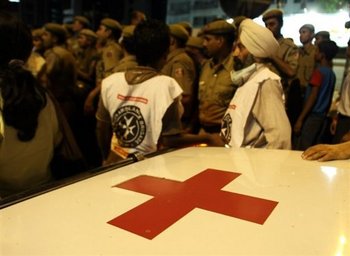 In fact, this was the third such wave this year alone.
In fact, this was the third such wave this year alone.
While families are mourning the loss of their loved ones, I can only express grief for their loss. I have read about individual acts of heroics:
“Last night was spent running from one department to the other looking for my son who had gone to Gaffar Market with his friends when the blast took place. He was injured and was helped by a young Sikh who brought him to the hospital on his scooter and later called us to inform that my son was injured. I did not even get a chance to thank the good Samaritan properly,” said Mohammed Ahmed. He said he was happy that his son was alive. [link]
However, soon afterwards, I have read some of the scariest reports of all. With people still in grief, fascists within the Indian state have not hesitated to hope for a sort of declaration of martial law over the entire country.
In the past, several posts have focused on the work of the Sikh Coalition around community mobilization to fight school bullying and the launch of an educational tool. 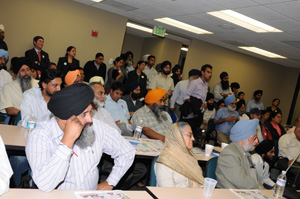 As part of the Sikh Coalition’s on-going work, it has opened a new office in Northern California to provide coast–to-coast civil/human rights advocacy for Sikhs. On September 10th, over 100 attendees, including local community members and politicians, celebrated the Sikh Coalition’s office opening in Fremont, California.
As part of the Sikh Coalition’s on-going work, it has opened a new office in Northern California to provide coast–to-coast civil/human rights advocacy for Sikhs. On September 10th, over 100 attendees, including local community members and politicians, celebrated the Sikh Coalition’s office opening in Fremont, California.
The Coalition’s, Western Regional Director, Neha Singh, said:
“Fremont is nationally the heart of the Sikh community … since we started, we’ve always taken cases from around the country, and a large amount of them were from the Bay Area. We thought it was now time to open an office in an area where a lot of the people requesting our services were.”
 Is the BBC biased towards creating religious programs focused predominantly on Islam versus other faiths? Apparently so, according to Hindu and Sikh leaders in the UK who claim that a disproportionate number of programs have been made about Islam, at the expense of programs on their own faiths. The Network of Sikh Organizations (NSO) media monitoring group analyzed programs from the BBC’s Religion and Ethics department and claim that since 2001, the BBC has made 41 programs on Islam, five on Hinduism and one on Sikhism.
Is the BBC biased towards creating religious programs focused predominantly on Islam versus other faiths? Apparently so, according to Hindu and Sikh leaders in the UK who claim that a disproportionate number of programs have been made about Islam, at the expense of programs on their own faiths. The Network of Sikh Organizations (NSO) media monitoring group analyzed programs from the BBC’s Religion and Ethics department and claim that since 2001, the BBC has made 41 programs on Islam, five on Hinduism and one on Sikhism.
Indarjit Singh, editor of the Sikh Messenger and a regular contributor to Thought for the Day on Radio 4’s Today programme, said Sikhs felt “brushed aside”. He said: “I think it’s probably unthinking, or inadvertent, but the bias is there. “I do know that within the Sikh community especially there is a feeling of concern over the lack of portrayal of their religion on television.” He added: “Of course it is important to educate non-Muslims about Islam, but it is also important to provide informative, open and respectful programming on all religions.” [link]
The people responsible for commissioning religious programming – whether on radio or television – acknowledge that world events have made a significant impact on their output – be it the death of John Paul II or the terrorist attacks of September 11 and July 7.
Once upon a time, a fellow langa(w)riter commented that you know you’ve made it as a ‘notable’ community, when you are featured on the game-show Jeopardy.
While she may or may not have been right, in today’s consumerist I think when a member of your own has a potato chip named after them that social recognition  grows near.
grows near.
Cricket has never featured very prominently at The Langar Hall, possibly as many commenters have noted, the current American-bias of this young blog. Despite the blog’s current limitations (which we do hope to change in the future), sometimes cricket does make it to our attention, albeit in ways still tied to the diaspora.
A recent article in a Californian newspaper discusses cricket’s popularity. Cricket aficionados have been gathering for years on weekends to come together to play cricket. From software engineers to truck drivers from small store owners to behavioral technicians, sports is one of those rare fields that maintains the potential to bring scores of people together. Although still hardly a blip in the American sporting world, cricket’s popularity continues to blossom:
[updates in italics]
The New York City school system has established a new process for reporting bias and bullying, prompted partially by Sikhs marching in Queens, led by the Sikh Coalition, two months ago. 1.1 million students will be affected by the new regulations. 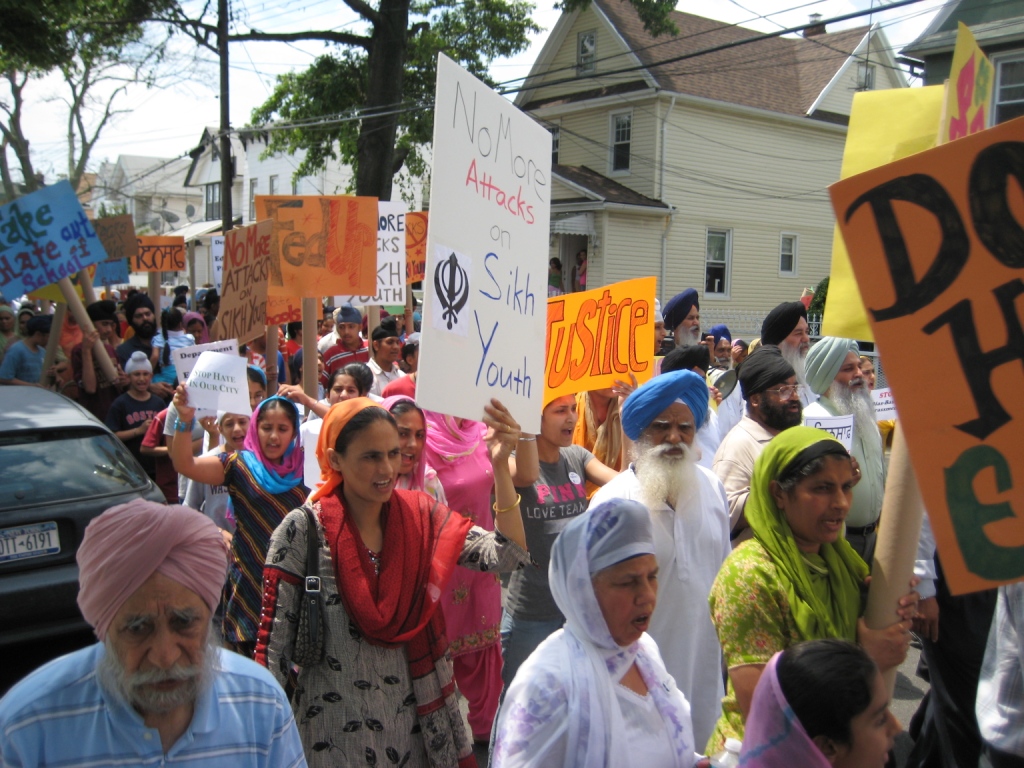
The new regulation — which is intended to prevent bullying based on a student’s ethnicity, national origin, religion, gender, sexual orientation or disability — comes two months after leaders of the Sikh population marched in Queens to protest attacks against Sikh students and what the leaders described as a lackluster response by the public school system. [link]
What is this new regulation? It includes several important provisions:
- Every principal must designate a staff member to whom students can report bullying and harassment episodes.
- A new e-mail address — RespectForAll@schools.nyc.gov — has been set up so that students who have been harassed, but do not feel comfortable reporting it to their school, can seek help.
- Each school must create an annual plan “to ensure that it has a safe and supportive learning environment,” and train students in the new rules so that they understand what behavior is prohibited and where to go for help if they have been bullied.
- Schools will have to report all complaints of harassment, intimidation or bullying within 24 hours, and conduct full investigations, including interviews and written statements.
- A full investigation of an incident within 5 days
- A written report for the alleged victim of the results of any incident within 10 days
- School staff members who witness or are told about bullying episodes must report them, and schools must contact the families of accused students. [link]
It seems that “Respect for All” will be a idea promoted by NY schools this coming year, and trends in bias-related bullying will also be tracked.
Newspapers in Panjab have been buzzing about the recent proposal by the Sikhs in Haryana to form their own Gurdwara political body. However, the Chief Minister of Punjab, Parkash Singh Badal, and head of the Akali Dal has been on a warpath trying to prevent such a move. Badal even went so far as to give a sort of veiled threat of the outcome by such a move:
“We are a peace-loving community and hope that attempts to open a fresh festering wound in the country in Punjab would be dropped. The whole of country is already up in flames and it can easily do without another trouble spot in Punjab along the lines of Jammu and Kashmir.” [link]
The problem with forming an opinion or even coming to terms with the situation is the layers of political intentions and motives. In a move to somewhat demystify and explain the situation, I write this post.
Here at TLH we’ve have lengthy discussions about the potential commodification of religious symbols and also about problematic media representation of groups of people. So, I thought that the recent hoopla over the questionable photo shoot in the August issue of Vogue India would be a colorful addition to those discussions. The New York Times reported that,
Vogue India’s August issue presented a 16-page vision of supple handbags, bejeweled clutches and status-symbol umbrellas, modeled not by runway stars or the wealthiest fraction of Indian society who can actually afford these accessories, but by average Indian people. [link]
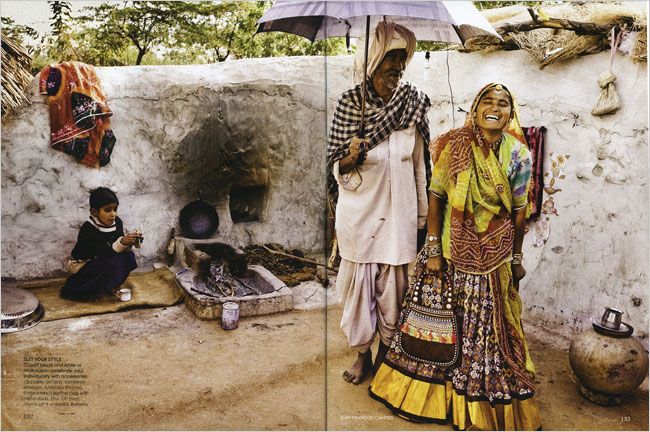 In one picture, a older poor woman holds a small child wearing a Fendi bib (cost = $100), in another pose a family preparing for their daily commute, sits on a motorbike with the mother riding the traditional sidesaddle way… oh and with her Hermès Birkin bag (cost = $10,000) on her wrist. Then of course, there is the turbaned man who models a Burberry umbrella (cost = $200). The photo spread itself is definitely striking. However, knowing that many Indians live on less than a dollar a day is even more striking when put in context with these exorbitant goods. The debate has raised questions from both sides of the table. Those that believe the photo shoot was distateful and that it exploits the poor by using them as props. Then there are others who believe this juxtaposition of wealth against poverty is a reality in India and exactly what people need to see.
In one picture, a older poor woman holds a small child wearing a Fendi bib (cost = $100), in another pose a family preparing for their daily commute, sits on a motorbike with the mother riding the traditional sidesaddle way… oh and with her Hermès Birkin bag (cost = $10,000) on her wrist. Then of course, there is the turbaned man who models a Burberry umbrella (cost = $200). The photo spread itself is definitely striking. However, knowing that many Indians live on less than a dollar a day is even more striking when put in context with these exorbitant goods. The debate has raised questions from both sides of the table. Those that believe the photo shoot was distateful and that it exploits the poor by using them as props. Then there are others who believe this juxtaposition of wealth against poverty is a reality in India and exactly what people need to see.
An Australian private school has agreed to apologize to a Sikh boy who was denied admission for his refusal to cut his hair and shave (as required by the school dress code). Surprisingly, this is the first time Australia has faced an anti-discrimination case of this nature:
The Anti-Discrimination Tribunal case was the first of its kind involving a Sikh student in Australia, although a British court found in a favour of a Sikh student in a similar trial more than 25 years ago.
An out-of-court settlement was reached in recent weeks after the school agreed to issue a public apology and pay the family undisclosed compensation. Ormiston College yesterday confirmed the settlement, which thwarts a public trial in the tribunal next month.
Australia has a system of minority rights protection that falls broadly under the “multiculturalist” umbrella (albeit in a very different way from the U.K. model). What I find amazing is the broad steps private schools are taking at this juncture to avoid accommodating religious minorities. Like the Sarika Singh case (also involving a private school), both of these schools are, at this point, familiar with its own Sikh community. Cultural competency and latent racism aren’t really compelling or effective screens for bigoted policies. In both cases, families had to turn to a legal remedy (and legal fees) to ensure access to a high quality education for their children.
There’s been a backlash around religious diversity in Western Europe for a while now, with the idea of “secularism” taking on a distinctly anti-religious (or, in most cases, anti-non-Christian-religions) flavor that isn’t really echoed in American conceptualizations of secularism. Do these two school cases mark the beginning of a reaffirmation of the principles underlying anti-discrimination laws? Is this a distinct position from what we see in France, Germany, Turkey and Italy?
Honor killings — generally understood to constitute an intentional ending of the life of someone who has brought shame on a family or to one’s self due to perceived or actual infidelity, unfaithfulness, or betrayal — regrettably occur in the Sikh community.
Indeed, Sikhs have been charged with engaging in both forms of honor killings. With respect to an honor killing where the family has been allegedly shamed, just days ago Reema discussed the case of Gurparkash Khalsa — a man who heard rumors that his daughter had been impregnated by Ajmer Singh Hothi and, “driven by humiliation over his daughter’s soiled reputation,” now stands accused of killing Hothi. With respect to an honor killing where the self has been allegedly shamed, Jaspal Sohal was “battered to death by her husband with a hammer. He saw killing her as preferable to having her leaving him and ‘damaging his izzat‘ (personal honour).”
The Khalsa matter took place in the United States while the Sohal incident in the United Kingdom. There may be a temptation to think that honor killings are a uniquely “foreign” or immigrant problem that happens to be taking place in Western societies. See for example this article entitled “‘Honor’ killing comes to the US.” But honor killings may be more universal than Western societies may want to admit. In fact, America has a long history of tolerating, at least to some extent, such killings.
Langa(w)riters have posted on AIDS/HIV infection amongst Sikh women here and here. We have discussed issues around support groups and causes of infection. One of the number one risk factors for contracting HIV/AIDS for Punjabi Sikh women is marriage. Many women are infected by their husbands who are intravenous drug addicts and/or clients of prostitutes. Not only are these women’s lives reaped with more havoc at no fault of their own, but there is also an insurmountable amount of stigma these women endure.
This past week, a Sikh woman, Kiranjit Kaur, stood up with tremendous strength and bravery to help combat this stigma. She become the poster-woman for people living with HIV/AIDS in Malaysia. At the age of 35, Kaur has decided to put her face to this disease because “I am here to help the ‘positive’ community and empower them and tell them they are not alone.”
Kiranjit Kaur contracted HIV in 1996 through her husband who was a former drug addict and has since passed away.
After contracting the disease she began working full-time with the Asian Pacific Council on AIDS Services as an advocate for other HIV/AIDS patients.
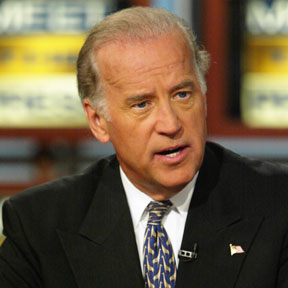 Once again, Indian-Americans have been unwillingly thrust into the heart of a contentious American political battle. For those of you who don’t remember, in 2006, incumbent Senator George Allen singled out and subsequently called an Indian-American, S.R. Sidarth, “macaca” while on the campaign trail. See video here. As The Washington Post’s national political reporter noted, Allen’s use of that slur was a “turning point” in his failed reelection bid, and became “an everlasting part of the political landscape.”
Once again, Indian-Americans have been unwillingly thrust into the heart of a contentious American political battle. For those of you who don’t remember, in 2006, incumbent Senator George Allen singled out and subsequently called an Indian-American, S.R. Sidarth, “macaca” while on the campaign trail. See video here. As The Washington Post’s national political reporter noted, Allen’s use of that slur was a “turning point” in his failed reelection bid, and became “an everlasting part of the political landscape.”
Just a few days ago, presumptive Democratic nominee Barack Obama selected fellow Senator Joe Biden to serve as his running mate. In 2006, Senator Biden said, “In Delaware, the largest growth of population is Indian-Americans, moving from India. You cannot go to a 7-Eleven or a Dunkin’ Donuts unless you have a slight Indian accent.” See video here.
Senator Obama’s decision has generated renewed interest in the 7-Eleven gaffe. See, e.g., here and here. The question is, should we care? In this post, I argue “yes.”
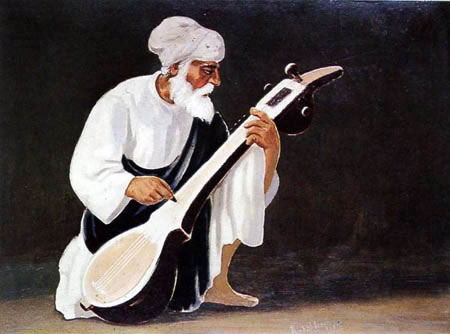 Unfortunately, and perhaps only for myself, I don’t remember the last time I visited one of my local gurdwaras and can say I was moved by the kirtan. Perhaps I feel that most (though not all) kirtan has become modernized to such an extent that it doesn’t really encompass the spiritual enlightenment that shabads were intended to. Actually, it was only after a recent visit to a Namdhari gurdwara that I truly felt that I had heard kirtan in its true element. For those of you who, like myself were unaware, Namdhari Sikhs believe that the only way to reach God is to sing in Raag, the mode of classical Indian music. For Namdhari Sikhs, the instruments they play and the style they sing in is very particular. They place a firm emphasis on rare instruments dating back to the 16th century, the time of Guru Nanak who continued the Vedic tradition of writing the holy scriptures in Raag.
Unfortunately, and perhaps only for myself, I don’t remember the last time I visited one of my local gurdwaras and can say I was moved by the kirtan. Perhaps I feel that most (though not all) kirtan has become modernized to such an extent that it doesn’t really encompass the spiritual enlightenment that shabads were intended to. Actually, it was only after a recent visit to a Namdhari gurdwara that I truly felt that I had heard kirtan in its true element. For those of you who, like myself were unaware, Namdhari Sikhs believe that the only way to reach God is to sing in Raag, the mode of classical Indian music. For Namdhari Sikhs, the instruments they play and the style they sing in is very particular. They place a firm emphasis on rare instruments dating back to the 16th century, the time of Guru Nanak who continued the Vedic tradition of writing the holy scriptures in Raag.
Gurmat Sangeet has always played a significant role in Sikh history and began in the 16th century as the musical expression of divine poetry and yet many of us have never been exposed to this form of kirtan. During our Gurus’ time, Gurmat Sangeet was devotional meditation and music and instruments were used as an accompianment.
Sikh music in the 16th and 17th centuries was comprised of the then-prevalent classical and folk music styles, accompanied by stringed and percussion instruments. The classical style was the devotional dhrupad style, a somber, deeply meditational style in which the text was of prime significance and the music played a supporting, albeit important role in the quest for Divine Essence. Folk music encompassed songs that marked various aspects of life – ghoriaan were sung at marriage, alaahniaan at death, and vaars to glorify brave warriors. [link]
It is said that Raags have a direct relationship to human moods; Soohi representing joy and seperation, Basant representing happiness, and Sarang, sadness. Information from the Sikh Music Heritage Institute states that Guru Nanak began Sikh music with the accompaniment of the rabab, a stringed melodic instrument; Guru Amar Das introduced the stringed instrument, saranda; and Guru Arjan Dev, developed the jori, a two-headed drum. During the 1920s a sharp decline in their use made them almost extinct. The harmonium took the place of stringed instruments and the tabla replaced the pakhaavaj and jori. There are various global efforts taking form to revive classical Sikh music. The Gurmat Sangeet department at Punjabi University, Patiala, the Raj Academy in the UK, and the Sikh Music Heritage Institute in California have dedicated resources to educating and training individuals to play traditional Sikh instruments with the hope that Gurmat Sangeet will be revived.
While those in the diaspora are less likely to follow, many in South Asia have had one eye on the Beijing Olympics and the other looking at the current situation in Kashmir.
This past Friday hundreds of thousands of Kashmiri protestors took to the street calling for ‘azadi’ (freedom) from the tyranny of the Indian state. Viewers in India have looked on in surprise and many different reactions can be found in the Indian press. I will highlight one.
For some more context, Al-Jazeera English has some excellent news analysis. It is a bit lengthy, but well-worth the watch:

